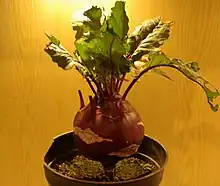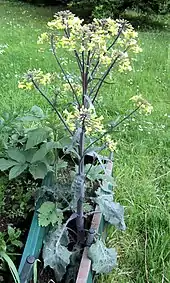Kohlrabi
Kohlrabi (pronounced /koʊlˈrɑːbi/; scientific name Brassica oleracea Gongylodes Group), also called German turnip or turnip cabbage, is a biennial vegetable, a low, stout cultivar of wild cabbage. It is a cultivar of the same species as cabbage, broccoli, cauliflower, kale, Brussels sprouts, collard greens, Savoy cabbage, and gai lan.
| Kohlrabi | |
|---|---|
.jpg.webp) Brassica oleracea var. gongylodes (kohlrabi) | |
| Species | Brassica oleracea |
| Cultivar group | Gongylodes Group |
| Cultivar group members | Many; see text. |
| Nutritional value per 100 g (3.5 oz) | |
|---|---|
6.2 g | |
| Sugars | 2.6 g |
| Dietary fiber | 3.6 g |
0.1 g | |
1.7 g | |
| Vitamins | Quantity %DV† |
| Vitamin A equiv. | 0% 2 μg |
| Thiamine (B1) | 4% 0.05 mg |
| Riboflavin (B2) | 2% 0.02 mg |
| Niacin (B3) | 3% 0.4 mg |
| Pantothenic acid (B5) | 3% 0.165 mg |
| Vitamin B6 | 12% 0.15 mg |
| Folate (B9) | 4% 16 μg |
| Vitamin B12 | 0% 0 μg |
| Vitamin C | 75% 62 mg |
| Vitamin D | 0% 0 μg |
| Vitamin E | 3% 0.48 mg |
| Vitamin K | 0% 0.1 μg |
| Minerals | Quantity %DV† |
| Calcium | 2% 24 mg |
| Iron | 3% 0.4 mg |
| Magnesium | 5% 19 mg |
| Manganese | 7% 0.139 mg |
| Phosphorus | 7% 46 mg |
| Potassium | 7% 350 mg |
| Selenium | 1% 0.7 μg |
| Sodium | 1% 20 mg |
| Other constituents | Quantity |
| Water | 91.00 g |
| |
| †Percentages are roughly approximated using US recommendations for adults. Source: USDA FoodData Central | |
It can be eaten raw or cooked. Edible preparations are made with both the stem and the leaves. Despite its common names, it is not the same species as turnip, although both are in the genus Brassica.
Etymology
The name comes from the German Kohl ("cabbage") plus Rübe ~ Rabi (Swiss German variant) ("turnip"), because the swollen stem resembles the latter.[1]
Its Group name Gongylodes (or lowercase and italicized gongylodes or gongyloides as a variety name) means "roundish" in Greek,[2] from gongýlos (γογγύλος, ‘round’).
In Iran, it is called kalam qomi or kalam qomri (کلم قمری) and is used for various dishes, including a type of soup. In the northern part of Vietnam, it is called su hào (from French chou-rave); in eastern parts of India (West Bengal) and Bangladesh, it is called ōl kapi.[3][4] It is also found in the Kashmir Valley in Northern India and is there known as monj-hakh,[5] monj being the round part, and hakh being the leafy part. In the hilly areas of Jammu region and its adjoining areas it is known as kādam (काडम) and is eaten throughout the year. It is called nol khol in Northern India, navalkōl (नवलकोल) in Maharashtra, nūlkōl (நூல்கோல்) in Tamil, “Ganthikobi” ଗଣ୍ଠିକୋବି in Odia, nūl kōl (నూల్ కోల్) in Telugu, navilu kōsu (ನವಿಲು ಕೋಸು) in Karnataka[6] and in Sri Lanka as knol khol (turnip cabbage).[7] In Cyprus it is known as kouloumpra (κουλούμπρα).[8] It is eaten in the Czech Republic under name kedlubna, while in Slovakia it is known as kaleráb. In Romania, it is the gulie or cărălabă, which is similar to the Polish kalarepa and to the Hungarian karalábé, all of these last three denominations being adaptations of the German word Kohlrabi.
History
The first European written record is by the botanist Mattioli in 1554 who wrote that it had “come lately into Italy”. By the end of the 16th century, kohlrabi spread to North Europe and was being grown in Austria, Germany, England, Italy, Spain, Tripoli and parts of the eastern Mediterranean.[9]
Description
Kohlrabi has been created by artificial selection for lateral meristem growth (a swollen, nearly spherical shape); its origin in nature is the same as that of cabbage, broccoli, cauliflower, kale, collard greens, and Brussels sprouts: they are all bred from, and are the same species as, the wild cabbage plant (Brassica oleracea).
The taste and texture of kohlrabi are similar to those of a broccoli stem or cabbage heart, but milder and sweeter, with a higher ratio of flesh to skin. The young stem in particular can be as crisp and juicy as an apple, although much less sweet.[10]

Except for the Gigante cultivar, spring-grown kohlrabi much over 5 cm in size tend to be woody, as do full-grown kohlrabi much over perhaps 10 cm in size; the Gigante cultivar can achieve great size while remaining of good eating quality.[11] The plant matures in 55–60 days after sowing and has good standing ability for up to 30 days after maturity. The approximate weight is 150 g. It grows well in hydroponic systems, producing a large edible bulk without clogging the nutrient troughs.


There are several varieties commonly available, including 'White Vienna',[12] 'Purple Vienna', 'Grand Duke', 'Gigante' (also known as "Superschmelz"), 'Purple Danube', and 'White Danube'. Coloration of the purple types is superficial: the edible parts are all pale yellow. The leafy greens can also be eaten. One commonly used variety grows without a swollen stem, having just leaves and a very thin stem, and is called Haakh. Haakh and Monj are popular Kashmiri dishes made using this vegetable. In the second year, the plant will bloom and develop seeds.
Preparation and use
Kohlrabi stems (the enlarged vegetal part) are surrounded by two distinct fibrous layers that do not soften appreciably when cooked. These layers are generally peeled away prior to cooking or serving raw, with the result that the stems often provide a smaller amount of food than one might assume from their intact appearance.
Although all parts of kohlrabi are edible, the bulbous stem is most frequently used, typically raw in salad or slaws. It has a texture similar to that of a broccoli stem, but with a flavor that is sweeter and less vegetal. It is also more crunchy and crisp than a raw broccoli stem.
Kohlrabi leaves are edible and can be used similarly to collard greens and kale, but take longer to cook.
Kohlrabi is an important part of Kashmiri cuisine, where it is called Mŏnji. It is one of the most commonly cooked vegetables, along with collard greens (haakh). It is prepared with its leaves and served with a light soup and eaten with rice.
In Cyprus, it is popularly sprinkled with salt and lemon and served as an appetizer.
Kohlrabi is a common ingredient in Vietnamese cuisine. It can also be found in the dish nem rán, stir fry and canh. Raw kohlrabi is usually sliced thinly for nộm or nước chấm.
References
- "Vegetable Dictionary - Kohlrabi". extension.illinois.edu. Archived from the original on 2019-05-12. Retrieved 2016-05-09.
- Stearn, William Thomas (1983). Botanical Latin. 275. David & Charles. ISBN 978-0-7153-8548-7.
gongylodes / gongyloides: roundish [also p. 323, Gongylodes (Knob-like): having an irregular roundish figure
- Ghosh, Ushnish (8 December 2010). "OL KOPI (Nool Kol, Ganth Gobi, Kadam, Kohlrabi) WITH GREEN and PANEER (PUNJABI & KASHMIRI)". 8 December 2010. ushnish.blogspot.co.uk. Retrieved 11 May 2017.
- "OL KOPI – KHOLRABI TORKARI". masalatize.com. Archived from the original on 27 March 2019. Retrieved 11 May 2017.
- "Ganth Gobi Kashmiri Style | Kashmiri Mundi | Kashmiri Kohlrabi Recipe". yummefy.com. Retrieved 2020-08-21.
- "Kohlrabi recipes - knolkohl bhaji - Navalkol subji, navilkosu palya". vegetarian Cooking Recipes Tips.
- John Whitchurch Bennett Ceylon and Its Capabilities (1843), p. 150, at Google Books
- "Κουλούμπρα, Κούρβουλα". Cyprus Food Museum.
- "Oxford Plats 400". University of Oxford.
- "Kohlrabi Is Weird! And Here's What You Can Do With It — Ingredient Spotlight". The Kitchn. Retrieved 2016-05-09.
- "Growing Kohlrabi - Bonnie Plants". Bonnie Plants. Retrieved 2016-05-09.
- "Early White Vienna Kohlrabi". rareseeds.com. Archived from the original on 26 June 2017. Retrieved 16 May 2017.
- Bailey, L. H., (1912, republished in 1975). Kohlrabi for stock-feeding. In Cyclopedia of American Agriculture: Vol. II--crops. Macmillan Publishing, New York. p. 389–390. ISBN 0-405-06762-3. Google Book Search. Retrieved on June 15, 2008.
What is Kohlrabi? Archived 2021-07-30 at the Wayback Machine
External links
 Media related to Brassica oleracea var. gongylodes at Wikimedia Commons
Media related to Brassica oleracea var. gongylodes at Wikimedia Commons- PROTAbase on Brassica oleracea (kohlrabi)
- Horticultural information on the tasty kohlrabi From the Learn2Grow databases
- Kohlrabi and Brussels Sprouts Are European
 Texts on Wikisource:
Texts on Wikisource:
- "Kohl-rabi". Encyclopedia Americana. 1920.
- "Kohl-rabi". New International Encyclopedia. 1905.